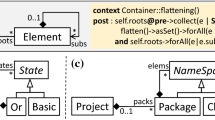In many applications, especially from the business domain, the requirements specification mainly deals with use cases and class models. Unfortunately, these models are based on different modelling techniques and aim at different levels of abstraction, such that serious consistency and completeness problems are induced. To overcome these deficiencies, we refine activity graphs to meet the needs for a suitable modelling element for use case behaviour. The refinement in particular supports the proper coupling of use cases via activity graphs and the class model. The granularity and semantics of our approach allow for a seamless, traceable transition of use cases to the class model and for the verification of the class model against the use case model. The validation of the use case model and parts of the class model is supported as well. Experience from several applications has shown that the investment in specification, validation and verification not only pays off during system and acceptance testing but also significantly improves the quality of the final product.
Similar content being viewed by others
Author information
Authors and Affiliations
Rights and permissions
About this article
Cite this article
Kösters, G., Six, HW. & Winter, M. Coupling Use Cases and Class Models as a Means for Validation and Verification of Requirements Specifications. Requirements Eng 6, 3–17 (2001). https://doi.org/10.1007/PL00010354
Issue Date:
DOI: https://doi.org/10.1007/PL00010354




